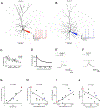Whole-Neuron Synaptic Mapping Reveals Spatially Precise Excitatory/Inhibitory Balance Limiting Dendritic and Somatic Spiking
- PMID: 32169170
- PMCID: PMC7244395
- DOI: 10.1016/j.neuron.2020.02.015
Whole-Neuron Synaptic Mapping Reveals Spatially Precise Excitatory/Inhibitory Balance Limiting Dendritic and Somatic Spiking
Abstract
The balance between excitatory and inhibitory (E and I) synapses is thought to be critical for information processing in neural circuits. However, little is known about the spatial principles of E and I synaptic organization across the entire dendritic tree of mammalian neurons. We developed a new open-source reconstruction platform for mapping the size and spatial distribution of E and I synapses received by individual genetically-labeled layer 2/3 (L2/3) cortical pyramidal neurons (PNs) in vivo. We mapped over 90,000 E and I synapses across twelve L2/3 PNs and uncovered structured organization of E and I synapses across dendritic domains as well as within individual dendritic segments. Despite significant domain-specific variation in the absolute density of E and I synapses, their ratio is strikingly balanced locally across dendritic segments. Computational modeling indicates that this spatially precise E/I balance dampens dendritic voltage fluctuations and strongly impacts neuronal firing output.
Copyright © 2020 Elsevier Inc. All rights reserved.
Conflict of interest statement
Declaration of Interests The authors declare no competing interests.
Figures







Similar articles
-
Emergence of synaptic organization and computation in dendrites.Neuroforum. 2022 Feb 23;28(1):21-30. doi: 10.1515/nf-2021-0031. Epub 2021 Dec 31. Neuroforum. 2022. PMID: 35881644 Free PMC article. Review.
-
Modelling the magnetic signature of neuronal tissue.Neuroimage. 2007 Aug 1;37(1):137-48. doi: 10.1016/j.neuroimage.2007.04.033. Epub 2007 May 4. Neuroimage. 2007. PMID: 17544300
-
Total number and distribution of inhibitory and excitatory synapses on hippocampal CA1 pyramidal cells.Neuroscience. 2001;102(3):527-40. doi: 10.1016/s0306-4522(00)00496-6. Neuroscience. 2001. PMID: 11226691
-
The Dendrites of CA2 and CA1 Pyramidal Neurons Differentially Regulate Information Flow in the Cortico-Hippocampal Circuit.J Neurosci. 2017 Mar 22;37(12):3276-3293. doi: 10.1523/JNEUROSCI.2219-16.2017. Epub 2017 Feb 17. J Neurosci. 2017. PMID: 28213444 Free PMC article.
-
Pyramidal neurons: dendritic structure and synaptic integration.Nat Rev Neurosci. 2008 Mar;9(3):206-21. doi: 10.1038/nrn2286. Nat Rev Neurosci. 2008. PMID: 18270515 Review.
Cited by
-
Emergence of synaptic organization and computation in dendrites.Neuroforum. 2022 Feb 23;28(1):21-30. doi: 10.1515/nf-2021-0031. Epub 2021 Dec 31. Neuroforum. 2022. PMID: 35881644 Free PMC article. Review.
-
What is the dynamical regime of cerebral cortex?Neuron. 2021 Nov 3;109(21):3373-3391. doi: 10.1016/j.neuron.2021.07.031. Epub 2021 Aug 30. Neuron. 2021. PMID: 34464597 Free PMC article. Review.
-
An Anatomical and Physiological Basis for Flexible Coincidence Detection in the Auditory System.bioRxiv [Preprint]. 2024 Nov 21:2024.02.29.582808. doi: 10.1101/2024.02.29.582808. bioRxiv. 2024. Update in: Elife. 2025 Apr 15;13:RP100492. doi: 10.7554/eLife.100492. PMID: 38464181 Free PMC article. Updated. Preprint.
-
Local changes in potassium ions regulate input integration in active dendrites.PLoS Biol. 2024 Dec 4;22(12):e3002935. doi: 10.1371/journal.pbio.3002935. eCollection 2024 Dec. PLoS Biol. 2024. PMID: 39630876 Free PMC article.
-
Synaptic microarchitecture: the role of spatial interplay between excitatory and inhibitory inputs in shaping dendritic plasticity and neuronal output.Front Cell Neurosci. 2024 Dec 20;18:1513602. doi: 10.3389/fncel.2024.1513602. eCollection 2024. Front Cell Neurosci. 2024. PMID: 39758273 Free PMC article. No abstract available.
References
-
- Acciai L, Soda P, and Iannello G (2016). Automated Neuron Tracing Methods: An Updated Account. Neuroinformatics 14, 353–367. - PubMed
-
- Alonso-Nanclares L, White EL, Elston GN, and DeFelipe J (2004). Synaptology of the proximal segment of pyramidal cell basal dendrites. Eur J Neurosci 19, 771–776. - PubMed
-
- Ascoli GA (2006). Mobilizing the base of neuroscience data: the case of neuronal morphologies. Nat Rev Neurosci 7, 318–324. - PubMed
Publication types
MeSH terms
Grants and funding
LinkOut - more resources
Full Text Sources
Research Materials
Miscellaneous

